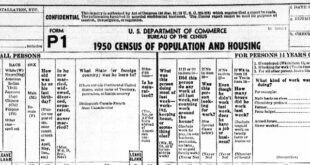The journey from Italy to America is most likely the most important part of the lives of our immigrant ancestors. It is certainly a major part of their history, and we need to understand as much as we can about those several weeks in their lives.
In the past couple of months, we learned a lot about their experiences aboard ship and at Ellis Island. We learned some tips on finding their passenger list at www.ellisisland.org. Now that we found it, what do we learn from it?
Please keep in mind that the older the passenger list is, the less information there is on it. A list from the late 1880s may only list the first initial and last name, the city they are staying in (Chicago) and not much else.
Lists from the 1900s, 1910s and early 1920s are very thorough. Lists later than the mid 1920s list the name, age, address and visa number. Oh, and how many hat boxes did they have!
Let’s focus on the good lists from the early 1900s. At the top, the heading contains the name of the ship, the date of departure and the port. Don’t forget that they had to travel over land to the nearest (or cheapest) port to embark.
On this page, there may be 25 or 50 people. The person you are looking for is only one row on this page. Usually, Ellis Island and Ancestry.com’s websites will tell you that the person you searched for is on line 21.
Then a lot of data is listed in columns, starting with surname and first name, in that order. The columns listed below are typically in this order, but the forms changed fairly often. They have columns for the age in years and months, but they only filled in the months when it was an infant less than a year old. Then the gender (“M” or “F”) and marital status (“M”arried, “S”ingle or “W”idowed) are listed. So far we have identifying information, but we cannot be 100 percent certain that this is Zio Francesco. There may be other people with the same age and the same name (especially first cousins of your Zio). Let’s keep looking at the columns.
Now we see calling/occupation. You see a lot of laborers, housewives and children. If your family lived near a coast, you’ll find some fishermen. There may be a column at this point asking if the immigrant can read or write. The next two columns are a little strange, unless you know your European history. “Nationality” (for us, Italy) and “Race or People” (Italian) seem like they would always be the same. You may find your “race” is “Italian South.” However, in many cases, a Polish immigrant was leaving Austria, back when there was no Poland on the map. So not everyone has the same nationality and “race,” as they called it back then.
The next column is critical, containing the “last permanent residence.” The older (pre-1900) passenger lists rarely list the name of the town, but the post-1900 lists usually do. Please keep in mind that the last place of residence is not always the same as the town of birth. But in many cases, when the last residence is different than the birthplace, it might mean that Zio Francesco moved to another town to marry his wife, and lived there for a while.
They now asked what city and state was the final destination. This can be crucial toward deciding if this is Zio Francesco or some other guy. If you know that Zio came directly to his brother’s house in Chicago, but the guy on the passenger list ended up in Secaucus, New Jersey, perhaps this isn’t the right person.
The next columns have to do with Zio’s financial status. Does he have a ticket to get him to Chicago (or Secaucus)? By whom was his passage paid? Whether in possession of $50 or not? The U.S. wanted to make sure that the immigrant didn’t just show up on their doorstep and not be able to get “home.” Fifty dollars was a lot of money in those days, so most immigrants did not have it. In fact, they got on board ships with money, but if they gambled, or lost the money to theft or negligence, they might have gotten off the boat with nothing. If so, they might be tagged as a “likely public charge” and held at Ellis Island until someone sent some money.
Now they asked if they had ever been in the U.S., and if so, when. This is very helpful to find that Zio was here from 1901-1905, and it explains why he had no kids for those five years.
The next column is hard to read because there is so much crammed on the page, but it contains the name of the nearest relative in America, and frequently the city and even the address. If it says he was living with his father Antonio, and you know his father was not Antonio, then this isn’t Zio. This is somebody else.
The next three columns are funny in a way. They asked the immigrant A) if he had ever been in prison or an insane asylum and B) if he was a polygamist or anarchist. “Why, yes, I was in prison in Italy for blowing up the mayor’s house!! My three wives were my accomplices!!” These columns are typically stamped “no”. Remember, back before 2001, when the airlines used to ask you if you packed a bomb in your luggage? I guess that started with Ellis Island!
They asked if the immigrant had a contract to work in the United States. One might think that the correct answer would be “Yes, I have a job already waiting for me.” However, you did not want to answer this way because they did not want people coming here and becoming indentured and using that to pay their passage. If you answered “yes,” you would be sent home.
Finally, they asked if the immigrant was in good health and if he was deformed or crippled. (Again, there was no political correctness in those days.) I learned my great-grandpa lost a finger. I never knew that before.
You should look at the people next to your Zio’s name in the list. It might be his wife and children born in Italy. This is the easiest way to find out if this is Zio or not.
Oh, by the way, if the entire line of information you just looked at has a line through it, then Zio didn’t come over on that boat! He might have booked passage, but never got on the ship.
If you have a chance, try to go through the pages on the manifest until you get to the end of the ship’s list. (There may be many pages, so please be patient.) Keep clicking next until you are there. You should see some pages about the crew, and more important, some pages about “Detained Aliens.” These are the immigrants who were held on Ellis Island for possible health reasons, lack of money or lack of transportation to Secaucus. Look for your Zio in these lists also. It might provide more details about his trip. These pages don’t usually show up in the search, so you have to manually look there on your own. You might find that your great-grandfather, who died in Italy, had actually tried to come here but was sent home.
It is pretty safe to assume that most of us do not have all these details from speaking to our immigrant ancestor. But we can put a fairly detailed story together of his arrival just from a few columns on a government form!
A final great piece of information is that they might have written a date and a series of numbers just above Zio’s line number on the passenger list. This is the naturalization date and petition number.
This is great information for finding the citizenship application and getting a whole new batch of genealogical information. We’ll talk about it next month.
Write to Dan at italianroots@comcast.net and please put “Fra Noi” in the subject line.
 Fra Noi Embrace Your Inner Italian
Fra Noi Embrace Your Inner Italian





